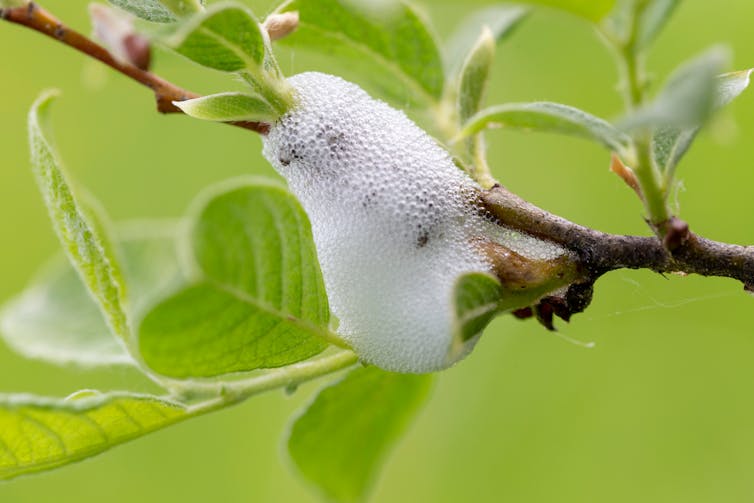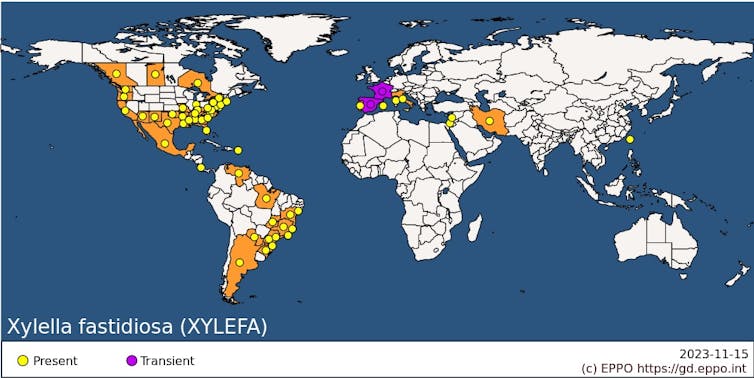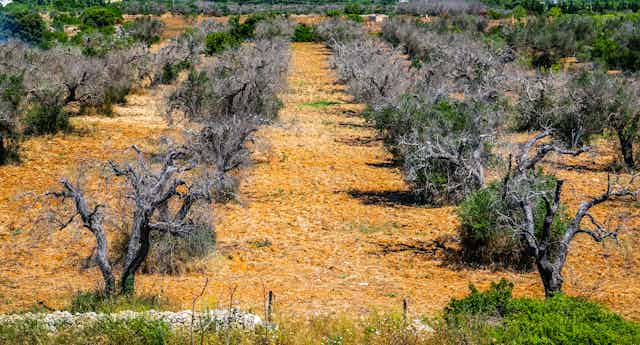Since 2013, over 20 million olive trees in Italy have succumbed to a devastating plant disease. The same disease now threatens many more plant species, across several countries, with the same fate.
Our recent research shows that the insect responsible for inadvertently transmitting the bacteria that cause this disease can feed on a vast number of different plant species. These include many herbaceous plants and trees that are commonly grown in gardens, parks and across the wider countryside in Britain.
During spring, gardeners will often wonder why blobs of spit-like foam have suddenly appeared on their favourite plants. Many will think them unsightly, perhaps even taking time to wash them off, only for the foam to appear again the next day.
This “spittle” is produced by an insect, unimaginatively called a spittlebug, whose juvenile stages immerse themselves in the foam in order to stop drying out and to protect themselves from predators.

There are several species of spittlebug. But one in particular has been shown to smash several entomological records.
The meadow spittlebug (Philaenus spumarius) can jump with such force that it accelerates faster than any other animal, equivalent to an extraordinary 550 times that of the Earth’s gravity. Even the toughest astronaut will die if faced with an acceleration more than eight times that of gravity.
These insects feed by sucking the sap out of plants. A typical adult meadow spittlebug will drink in and then excrete up to 200 times its body weight of fluid per day: another record, and the equivalent of an average human excreting 13,000 litres each day.
Most recently, our research has found that this insect has far broader tastes than any other insect known to science; it can feed on over 1,300 species of plant.
Why does this matter?
The meadow spittlebug can transmit a bacterium called Xylella fastidiosa that is potentially deadly for the plants on which it feeds. When the spittlebug uses its syringe-like mouthparts to suck out the plant’s sap, the bacteria can get into the tubes that draw fluids up from the roots. Once there, the bacteria proliferate and block these tubes, starving the plant of water.
The symptoms of infection include scorched or stunted leaves. But, as these symptoms can be confused with several other plant problems, such as dehydration, a definitive diagnosis is difficult. To complicate matters further, some infected plants do not show any symptoms, at least not immediately, making them undetected reservoirs of the bacteria.
The bacteria have caused problems on an epic scale in Apulia, Italy’s premier olive-growing region. Entire groves of ancient olive trees have died or have been deliberately destroyed to stop the spread of this devastating plant disease.

The list of plant species that are known to be susceptible to this disease is long and growing. It already includes 690 species across 88 plant families, encompassing not just trees, but many popular garden plants, important horticultural crops and even some arable crops.
Spittlebugs in Britain
As part of our research, we asked members of the British public to send us their sightings of spittle. We received over 17,000 responses. Our results suggest that the insect is widespread in almost all British habitats, including gardens, and on an enormously diverse range of plants.
Fortunately, Britain and most of northern Europe are not yet in the grip of this plant disease. But the ubiquitous distribution of the spittlebug vector and its fondness for such a variety of different plants means that if the bacteria were ever accidentally introduced to Britain, it would be able to spread rapidly with potentially devastating consequences.
Scientists in Britain are anxiously watching for signs of any northward spread of the disease on the European continent. It originated in the Americas and was first detected in Apulia, Italy, in 2013, but it has since been reported in southern France, Spain and Portugal. Certain strains of the disease could certainly tolerate cooler northern temperatures, and their spread may be facilitated by our warming climate.
The global distribution of Xylella fastidiosa

Stopping the spread
Spittlebugs don’t fly very far so are unlikely to bring the disease into Britain themselves. The most likely entry route would be through plants brought in via the horticultural trade.
Historically, Britain has imported both lavender and olive trees from Italy. However, these plants now have to go through strict importation and quarantine controls.
It is critically important that British holidaymakers in Mediterranean countries do not bring home live plant material of any kind. Xylella fastidiosa has not been detected in Britain so far, but the spittlebug’s extraordinarily broad taste in food shows that it would be extremely hard to control if it ever did arrive.

Don’t have time to read about climate change as much as you’d like?
Get a weekly roundup in your inbox instead. Every Wednesday, The Conversation’s environment editor writes Imagine, a short email that goes a little deeper into just one climate issue. Join the 20,000+ readers who’ve subscribed so far.

